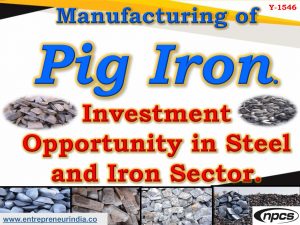
Manufacturing of Pig Iron. Investment Opportunity in Steel and Iron Sector.
Pig iron is the product of smelting iron ore (also ilmenite) with a high-carbon fuel and reductant such as coke, usually with limestone as a flux. Charcoal and anthracite are also used as fuel and reductant. Pig iron is produced by smelting or iron ore in blast furnaces or by smelting ilmenite in electric furnaces.
Pig iron is an intermediate product of the iron industry also known as crude iron, which is obtained by smelting iron ore in a blast furnace. When the metal had cooled and hardened the smaller ingots (the pigs) were simply broken from the runner (the sow) hence the name pig iron.
Pig iron types are used to dilute all the elements in ductile iron which is a harmful process. Pig iron contains low residual, lower nitrogen steel, has a consistent chemistry, promote slag conditions and improve process control.
There are three types of merchant pig iron, which are as follows: Basic pig iron this is used in electric arc furnace for the purpose of steel making. Foundry pig iron this type of pig iron is also known as hematite pig iron and is used in cupola furnaces for grey iron castings.
Pig iron is used for making steel and pure iron units. It has very high carbon content along with silica and another constituent of dross. Pig iron made from smelting iron indulges with the high amount of carbon for further processing steps.
Market Outlook
Pig iron prices in India’s domestic market have crashed to Rs 21,000 ($460) per tonne from around Rs 31,000 per tonne a month ago.
The growth in the Indian steel sector has been driven by domestic availability of raw materials such as iron ore and cost-effective labour. Consequently, the steel sector has been a major contributor to India’s manufacturing output.
The Indian iron industry is very modern with state-of-the-art steel mills. It has always strived for continuous modernization and up-gradation of older plants and higher energy efficiency levels. Indian steel industries are classified into three categories such as major producers, main producers and secondary producers.
Iron & Steel Industry in India
Global iron & steel market is expected to witness rapid growth owing to strong demand from construction and transportation sector. Rapid industrialization and urbanization, particularly in the emerging regions such as Asia Pacific and Central & South America are expected to drive the overall iron & steel market.
Growing demand from the building and construction industry owing to rapid infrastructure initiatives undertaken by governments especially in the emerging regions is projected to aid in industry growth. Building & construction industry is the dominant end-use industry for this market followed by automotive & transportation.
Emerging economies such as Brazil, China, Russia, and India have witnessed rapid automotive demand owing to factors such as rising disposable income, rapid urbanization, and increase in population. This trend is presumed to continue, and thus, assist the regional market in the near future.
Environmental concerns regarding excessive mining have resulted in several regulations being implemented to curb mining. Emerging economies such as China, which is the largest consumer of steel, has witnessed government regulations mandating steel companies to limit its production in a bid to reduce mining. Such regulatory framework is anticipated to hamper the regional as well as global market.
China has witness brisk demand growth in the recent past. This growth has encouraged several industry participants to increase their production capacity in a bid to meet the demand. However such rapid growth in production capacities has resulted in chronic overcapacity which has driven down prices. Any impact in the Chinese market cascades across the global market as China is the largest consumer and producer of steel. The ‘Global and Chinese Pig iron Industry 2013-2023 Market.
Steel is crucial to the development of any modern economy and is considered to be the backbone of human civilization. The level of per capita consumption of steel is treated as an important index of the level of socio-economic development and living standards of the people in any country. Steel is a product of a large and technologically complex industry having strong forward and backward linkages and all major industrial economies have been largely shaped by the strength of their steel industries.
India’s economic growth is dependent on the growth of the Indian steel Industry. Steel continues to have a stronghold in traditional sectors such as construction, Housing and Roads, special steels are increasingly being used in engineering industries such as power generation, petrochemicals and fertilizers. India occupies a central position on the global steel map, with state-of-the-art steel mills, acquisition of global scale capacities by players, continuous modernization and up gradation of older plants, improving energy efficiency and backward integration with global raw material sources.
Key Players
- Bridon International Ltd.,
- ArcelorMittal S.A.,
- Kobe Steel Ltd.,
- Insteel Industries Inc.,
- V. Bekaert SA,
- Steel Authority of India Ltd.
- POSCO, Tata Steel Ltd.,
- Rio Tinto,
- BHP,
- Vale,
- Tree Island Industries Ltd.,
- Leggett & Platt Incorporated
See More
https://niir.org/profile-project-reports/profiles/steel-steel-products-iron-steel-ferrous-metals-products-alloy-steel-cold-rolling-foundry-hot-rolling-pelletizing-rolling-rolling-mill-stainless-steel-steel-mill-tinplate-carbon-steel-forge-products-mild-steels-projects/z,,21,96,a/index.html?_sort_by=default